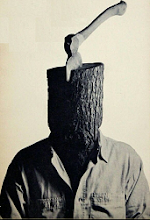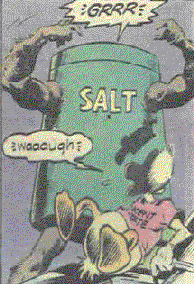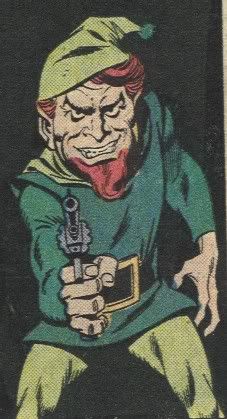Penetrating Insight or Flatulent Nonsense: You Be the Judge
Big theory time! Woo!
Comic book superheroes face danger all the dang time: gun-wielding muggers, mad world conquerors, an irradiated Barry Gibb out to destroy the universe with the shattering power of his vibrato and massive hairdo, this danger takes any number of forms. Their ability to face and overcome certain death is central to their existence as superheroes.
I think that the way superheroes deal with physical danger correlates strongly with their characterization. My theory is that powers and personalities can be categorized by the three basic survival methods superheroes have.
Say the Crabgrass Conquistador yells "Die, do-gooding scum!" and fires a gun at a superhero. One of three things will happen:
1. The bullets don’t affect him. The hero has a form of protection.
2. The bullets miss. The hero outmaneuvered them somehow
3. The bullets hurt our hero, but they don’t stop him. Instead, he presses on.
The archetypes of these heroes are pretty obvious. #1 is Superman, #2 is Spider-Man, #3 is Wolverine.*
Think of the “invulnerable” heroes, the ones who, when shot at, can just stand there. Superman, Captain America, Iron Man, any of the Fantastic Four, the Martian Manhunter, Green Lantern, Power Man, those folks. They tend to have a common character trait: upright steadfastness. These tend towards the Boy Scout side of the spectrum, though this quality might be obscured by surface gruffness.
Now how about the “dodgers:” Spider-Man, Daredevil, Batman, Nightwing, the Flash, those fellows. They tend to be known for quick-wittedness as well, and are generally less incorruptable than the "invulnerables."
Then there are the “bleeders:” Wolverine, the Punisher, some interpretations of Batman, some interpretations of the Hulk, those guys. Here the characters are more known for their rage than anything else. They exist to exchange eyes for eyes, or worse.
I think the characterization matching the power-type is an unconscious cliché of the industry. It makes sense, after all. The overwhelming sense of power created by the bulletproof hero, coupled with the rage of the bleeder hero, would be bizarre and frightening. Or imagine a bleeder hero who was a squeaky-clean sort of fellow. He’s bleeding from nineteen gunshot wounds, all smiles and talking about the importance of good citizenship.
Even typing that feels weird.
Super powers are essentially extensions of character. Superman is Goodness Personified, the Unsullied One. Thus, he cannot be harmed. Spider-Man is the Good Guy Trying To Get By. Thus, he can be hurt like you and me, but does what it takes to avoid it. Wolverine is Rage With A Bad Haircut. Thus, he suffers great pain to make his later inflicting of pain seem justified.
In large part, these characters are their powers, and their powers are their characters.
Batman illustrates this idea.** For most of his history, Batman dodged bullets and other nastiness headed his way. When his stories became darker and more violent in the seventies, he began to suffer injuries, even to be shot once in a while. He was hurt more, and he hurt others more.
Currently Batman treads the line between “dodger” and “bleeder,” varying with the writer, with his characterization changing to match. The “dodging” Batman is a detective and an adventurer. The “bleeding” Batman is a revenge-driven vigilante. Compare the violence received and doled out by Batman in a story with his behavior in that same story. There’s a significant correlation.
I’m grossly oversimplifying, I know. This is just one of those crackpot theories that pops up in my head from time to time.
...
I should add that there’s a fourth category of superhero “bullet coping method:” never getting shot at.***
Take Cyclops of the X-Men. He’s a dude with lasers coming out of his eyes. That’s it. He’s not bulletproof, he’s not super-agile or fast, and he doesn’t have the capacity to survive lots of bodily harm. Shoot him, and he’ll die.
How do comic creators deal with this? Easy. Nobody ever shoots at him.
The common thread among these characters is their placement deep in their fantasy worlds. Cyclops doesn’t face muggers and terrorists, he faces eeeevil mutants named “Nutria, the Nipplebacked Rat-Man” and clones of Magneto’s car-salesman cousin Lenny. Generally threats don’t reach him, or they mysteriously miss.
I’m tempted to argue that these characters’ remove from everyday life is reflected in their character, but I haven’t puzzled over this long enough to make such a sweeping (and seemingly pointless) statement.
…
These theories do lead to two obvious follow-up questions: “Isn’t this obvious?” and “So what?”
To the first question: yeah, okay, it probably is.
To the second question: I think it could be useful to examine these often-unstated assumptions. New approaches to the genre could emerge. Hey, they might even be interesting.
How about a superhero team consisting of a super-agile guy who’s Mister Boy Scout, a guy with healing powers who’s the group’s thinker, and a bulletproof mook with a bloodlust? Or a hero who has no good defense against getting killed but lives in the real (by comic standards) world and insists on heroing anyway? Just off the top of my head here.
If nothing else, forming a clearer understanding of the mechanics of soopa-hero characters and their appeal seems a slightly worthwhile endeavor.
…
Another thought: comic heroes tend to be violent in direct proportion to the violence done to them. In a warped way, the manglings frequently given to Wolverine or the Punisher seem to be interpreted as the moral justification for their bloody rampages. “They done him wrong” is a common justification for bloodbaths.
Imagine a hero who gets mangled frequently but never himself mangles. Would it irritate the readers? Seem unbalanced and unsatisfying? The rush of gratuitous violence is lessened, I wager, when the audience identification character is the victim, and his “payback” is of lesser brutality.**** After all, the payback is the reason people dig such books. People love revenge stories.
…
Good lord, I do ramble sometimes. Any thoughts?
------------------
*You might think #2 should be Batman, but no. He’s a transitional figure. I’ll get into that in a few paragraphs. (By the way, I can’t call him “The Batman.” It just sounds silly to me. Though I’m okay with “The Flash.” Calling him “Flash” sounds silly. Maybe it’s the suffix “-man” that makes the definate article seem unnecessary? Hmmm…)
**Quick dorky aside: to any who object by saying "But Batman doesn't have super-powers," I disagree. Homey can dodge bullets and absorb inhuman amounts of punishment. By real-world standards, those are amazing super-powers. I don't care how long you "train," you can't do that. Comic standards say he's not super-powered. My standards say he most certainly does.
***Okay, there is a fifth type, almost never seen: the hero who dies but comes back a lot. The Immortal Man, Resurrection Man, Mr. I of the Great Lakes Avengers, those fellows. But they’re rare enough that I can skip ‘em here.
****I can see the book now: “He’s…Jesus-Man! Come to take a beating from the villains and then forgive ‘em! Read this month’s exciting martial arts issue: Kung Fu, Karate and Judo-Christian Ethics!”
Hm. I can’t imagine that’d sell big in the comic world (unless it kept my puns, of course).
Comic book superheroes face danger all the dang time: gun-wielding muggers, mad world conquerors, an irradiated Barry Gibb out to destroy the universe with the shattering power of his vibrato and massive hairdo, this danger takes any number of forms. Their ability to face and overcome certain death is central to their existence as superheroes.
I think that the way superheroes deal with physical danger correlates strongly with their characterization. My theory is that powers and personalities can be categorized by the three basic survival methods superheroes have.
Say the Crabgrass Conquistador yells "Die, do-gooding scum!" and fires a gun at a superhero. One of three things will happen:
1. The bullets don’t affect him. The hero has a form of protection.
2. The bullets miss. The hero outmaneuvered them somehow
3. The bullets hurt our hero, but they don’t stop him. Instead, he presses on.
The archetypes of these heroes are pretty obvious. #1 is Superman, #2 is Spider-Man, #3 is Wolverine.*
Think of the “invulnerable” heroes, the ones who, when shot at, can just stand there. Superman, Captain America, Iron Man, any of the Fantastic Four, the Martian Manhunter, Green Lantern, Power Man, those folks. They tend to have a common character trait: upright steadfastness. These tend towards the Boy Scout side of the spectrum, though this quality might be obscured by surface gruffness.
Now how about the “dodgers:” Spider-Man, Daredevil, Batman, Nightwing, the Flash, those fellows. They tend to be known for quick-wittedness as well, and are generally less incorruptable than the "invulnerables."
Then there are the “bleeders:” Wolverine, the Punisher, some interpretations of Batman, some interpretations of the Hulk, those guys. Here the characters are more known for their rage than anything else. They exist to exchange eyes for eyes, or worse.
I think the characterization matching the power-type is an unconscious cliché of the industry. It makes sense, after all. The overwhelming sense of power created by the bulletproof hero, coupled with the rage of the bleeder hero, would be bizarre and frightening. Or imagine a bleeder hero who was a squeaky-clean sort of fellow. He’s bleeding from nineteen gunshot wounds, all smiles and talking about the importance of good citizenship.
Even typing that feels weird.
Super powers are essentially extensions of character. Superman is Goodness Personified, the Unsullied One. Thus, he cannot be harmed. Spider-Man is the Good Guy Trying To Get By. Thus, he can be hurt like you and me, but does what it takes to avoid it. Wolverine is Rage With A Bad Haircut. Thus, he suffers great pain to make his later inflicting of pain seem justified.
In large part, these characters are their powers, and their powers are their characters.
Batman illustrates this idea.** For most of his history, Batman dodged bullets and other nastiness headed his way. When his stories became darker and more violent in the seventies, he began to suffer injuries, even to be shot once in a while. He was hurt more, and he hurt others more.
Currently Batman treads the line between “dodger” and “bleeder,” varying with the writer, with his characterization changing to match. The “dodging” Batman is a detective and an adventurer. The “bleeding” Batman is a revenge-driven vigilante. Compare the violence received and doled out by Batman in a story with his behavior in that same story. There’s a significant correlation.
I’m grossly oversimplifying, I know. This is just one of those crackpot theories that pops up in my head from time to time.
...
I should add that there’s a fourth category of superhero “bullet coping method:” never getting shot at.***
Take Cyclops of the X-Men. He’s a dude with lasers coming out of his eyes. That’s it. He’s not bulletproof, he’s not super-agile or fast, and he doesn’t have the capacity to survive lots of bodily harm. Shoot him, and he’ll die.
How do comic creators deal with this? Easy. Nobody ever shoots at him.
The common thread among these characters is their placement deep in their fantasy worlds. Cyclops doesn’t face muggers and terrorists, he faces eeeevil mutants named “Nutria, the Nipplebacked Rat-Man” and clones of Magneto’s car-salesman cousin Lenny. Generally threats don’t reach him, or they mysteriously miss.
I’m tempted to argue that these characters’ remove from everyday life is reflected in their character, but I haven’t puzzled over this long enough to make such a sweeping (and seemingly pointless) statement.
…
These theories do lead to two obvious follow-up questions: “Isn’t this obvious?” and “So what?”
To the first question: yeah, okay, it probably is.
To the second question: I think it could be useful to examine these often-unstated assumptions. New approaches to the genre could emerge. Hey, they might even be interesting.
How about a superhero team consisting of a super-agile guy who’s Mister Boy Scout, a guy with healing powers who’s the group’s thinker, and a bulletproof mook with a bloodlust? Or a hero who has no good defense against getting killed but lives in the real (by comic standards) world and insists on heroing anyway? Just off the top of my head here.
If nothing else, forming a clearer understanding of the mechanics of soopa-hero characters and their appeal seems a slightly worthwhile endeavor.
…
Another thought: comic heroes tend to be violent in direct proportion to the violence done to them. In a warped way, the manglings frequently given to Wolverine or the Punisher seem to be interpreted as the moral justification for their bloody rampages. “They done him wrong” is a common justification for bloodbaths.
Imagine a hero who gets mangled frequently but never himself mangles. Would it irritate the readers? Seem unbalanced and unsatisfying? The rush of gratuitous violence is lessened, I wager, when the audience identification character is the victim, and his “payback” is of lesser brutality.**** After all, the payback is the reason people dig such books. People love revenge stories.
…
Good lord, I do ramble sometimes. Any thoughts?
------------------
*You might think #2 should be Batman, but no. He’s a transitional figure. I’ll get into that in a few paragraphs. (By the way, I can’t call him “The Batman.” It just sounds silly to me. Though I’m okay with “The Flash.” Calling him “Flash” sounds silly. Maybe it’s the suffix “-man” that makes the definate article seem unnecessary? Hmmm…)
**Quick dorky aside: to any who object by saying "But Batman doesn't have super-powers," I disagree. Homey can dodge bullets and absorb inhuman amounts of punishment. By real-world standards, those are amazing super-powers. I don't care how long you "train," you can't do that. Comic standards say he's not super-powered. My standards say he most certainly does.
***Okay, there is a fifth type, almost never seen: the hero who dies but comes back a lot. The Immortal Man, Resurrection Man, Mr. I of the Great Lakes Avengers, those fellows. But they’re rare enough that I can skip ‘em here.
****I can see the book now: “He’s…Jesus-Man! Come to take a beating from the villains and then forgive ‘em! Read this month’s exciting martial arts issue: Kung Fu, Karate and Judo-Christian Ethics!”
Hm. I can’t imagine that’d sell big in the comic world (unless it kept my puns, of course).





3 Comments:
And then there's The Spirit - a squeaky clean do-gooder who got the crap beaten out of him all the time and, while he certainly hit back, his goal was catching crooks not getting brutal revenge.
By David Lee Ingersoll, at 1:32 PM
David Lee Ingersoll, at 1:32 PM
I always found it very telling that in a crowd of X-men, Wolverine is the ONLY ONE to get hurt. It's as if he's singled out for painful punishment. I agree with you, the writers do tend to follow those cliches with unerring accuracy. I never understood the heroes ending unmolested after a blazing gun battle.
Keep in mind, even in the real world, heroes train for years to dodge bullets, while most bad guy shooters never even train at holding a gun.
By Paul, at 10:15 AM
Paul, at 10:15 AM
Try Milestone's old book Xombi: the main character is infested with nanites, giving him a super-healing factor. Guy could be ground into hamburger, and he would come back.
Downsides: well, he was an ordinary guy with ordinary strength, so it wasn't like he could lay the smack down. Also, being ground into hamburger would hurt like all get out. He didn't have any defense against pain. So did the book fail because it's hard to identify with someone who has to take pain without being able to dish it out in kind?
Hmm...well, no, I think the market just kind of imploded back then. Good article though!
By Anonymous, at 4:43 PM
Anonymous, at 4:43 PM
Post a Comment
<< Home